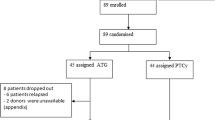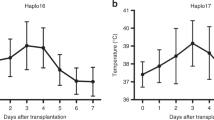Summary:
Alemtuzumab is effective in reducing the risk of acute graft-versus-host disease (GVHD) after allogeneic stem cell transplantation (ASCT). Alemtuzumab may also delay immune reconstitution and reduce graft-versus-leukemia effects. The optimal dose has not been established. We investigated engraftment, acute GVHD incidence and severity, and pharmacokinetics of alemtuzumab associated with the use of low-dose alemtuzumab/cyclophosphamide/total body irradiation and ASCT for patients with aggressive CD52-positive hematologic malignancies. In all, 12 patients were treated. Alemtuzumab 10 mg daily on days −7 to −3 was given intravenously. Tacrolimus and methotrexate were used for GVHD prophylaxis. Alemtuzemab was not detected in any of the 36 sequential serum samples tested between days −1 and +21 of transplant. All patients engrafted rapidly; the median time to an absolute neutrophil count >0.5 × 109/l was 14 days (range 11–17 days), and the median time to a platelet count >20 × 109/l was 16 days (range 6–30 days). By 1 month after transplant, nine patients had 100% donor chimerism, while three had mixed donor chimerism. At 3 months, 11 had achieved 100% donor chimerism. No cases of grade III/IV acute GVHD occurred. At a median follow-up interval of 14.7 months (range 4–24), seven patients remained alive, and five remained free of disease.
This is a preview of subscription content, access via your institution
Access options
Subscribe to this journal
Receive 12 print issues and online access
$259.00 per year
only $21.58 per issue
Buy this article
- Purchase on Springer Link
- Instant access to full article PDF
Prices may be subject to local taxes which are calculated during checkout


Similar content being viewed by others
References
Ginaldi L, De Martinis M, Matutes E et al. Levels of expression of CD52 in normal and leukemic B and T cells: correlation with in vivo therapeutic responses to Campath-1H. Leuk Res 1998; 22: 185–191.
Gilleece MH, Dexter TM . Effect of Campath-1H antibody on human hematopoietic progenitors in vitro. Blood 1993; 82: 807–812.
Hale G . The CD52 antigen and development of the Campath antibodies. Cytotherapy 2001; 3: 137–143.
Keating MJ, Flinn I, Jain V et al. Therapeutic role of alemtuzumab (Campath-1H) in patients who have failed fludarabine: results of a large international study. Blood 2002; 99: 3554–3561.
Osterborg A, Dyer MJ, Bunjes D et al. Phase II multicenter study of human CD52 antibody in previously treated chronic lymphocytic leukemia. European Study Group of CAMPATH-1H Treatment in Chronic Lymphocytic Leukemia. J Clin Oncol 1997; 15: 1567–1574.
Osterborg A, Fassas AS, Anagnostopoulos A et al. Humanized CD52 monoclonal antibody Campath-1H as first-line treatment in chronic lymphocytic leukaemia. Br J Haematol 1996; 93: 151–153.
Lundin J, Kimby E, Bjorkholm M et al. Phase II trial of subcutaneous anti-CD52 monoclonal antibody alemtuzumab (Campath-1H) as first-line treatment for patients with B-cell chronic lymphocytic leukemia. Blood 2002; 100: 768–773.
Pawson R, Dyer MJ, Barge R et al. Treatment of T-cell prolymphocytic leukemia with human CD52 antibody. J Clin Oncol 1997; 15: 2667–2672.
Keating MJ, Cazin B, Coutre S et al. Campath-1H treatment of T-cell prolymphocytic leukemia in patients for whom at least one prior chemotherapy regimen has failed. J Clin Oncol 2002; 20: 205–213.
Dearden C, Matutes E, Cazin B et al. High remission rate in T-cell prolymphocytic leukemia with Campath-1H. Blood 2001; 98: 1721–1726.
Dyer MSJ, Hale G, Marcus R Waldmann H . Remission induction in patients with lymphoid malignancies using unconjugated Campath-1H monoclonal antibodies. Leuk Lymphoma 1990; 2: 179–193.
Hale G, Jacobs P, Wood L et al. CD52 antibodies for prevention of graft-versus-host disease and graft rejection following transplantation of allogeneic peripheral blood stem cells. Bone Marrow Transplant 2000; 26: 69–76.
Hale G, Waldmann H . Recent results using CAMPATH-1 antibodies to control GVHD and graft rejection. Bone Marrow Transplant 1996; 17: 305–308.
Hale G, Cobbold S, Waldmann H . T cell depletion with CAMPATH-1 in allogeneic bone marrow transplantation. Transplantation 1988; 45: 753–759.
Clarke E, Potter MN, Hale G et al. Double T cell depletion of bone marrow using sequential positive and negative cell immunoaffinity or CD34+ cell selection followed by Campath-1M; effect on CD34+ cells and progenitor cell recoveries. Bone Marrow Transplant 1998; 22: 117–124.
Perez-Simon JA, Kottaridis PD, Martino R et al. Nonmyeloablative transplantation with or without alemtuzumab: comparison between 2 prospective studies in patients with lymphoproliferative disorders. Blood 2002; 100: 3121–3127.
Chakraverty R, Peggs K, Chopra R et al. Limiting transplantation-related mortality following unrelated donor stem cell transplantation by using a nonmyeloablative conditioning regimen. Blood 2002; 99: 1071–1078.
Cull GM, Haynes AP, Byrne JL et al. Preliminary experience of allogeneic stem cell transplantation for lymphoproliferative disorders using BEAM-CAMPATH conditioning: an effective regimen with low procedure-related toxicity. Br J Haematol 2000; 108: 754–760.
Kottaridis PD, Milligan DW, Chopra R et al. In vivo CAMPATH-1H prevents graft-versus-host disease following nonmyeloablative stem cell transplantation. Blood 2000; 96: 2419–2425.
Manshouri T, Keating M, Giles FS et al. Measuring Campath-1H: validation of a sensitive and simple enzyme-linked immunosorbent assay. Blood 2002; 100: 360b.
Morris EC, Rebello P, Thomson KJ et al. Pharmacokinetics of alemtuzumab used for in vivo and in vitro T-cell depletion in allogeneic transplantation: relevance for early adoptive immunotherapy and infectious complication. Blood 2003; 102: 404–406.
Morris E, Thomson K, Craddock C et al. Long-term follow-up of an alemtuzumab (Campath-1h) containing reduced intensity allogeneic transplant regimen for non-Hodgkin's lymphoma (NHL). Blood 2002; 100: 40a.
Przepiorka D, Cortes J, Folloder J et al. Allogeneic transplantation for adult lymphocytic leukemia. Blood 1998; 10: 354b.
Klangsinsirikul P, Carter GI, Byrne JL et al. Campath-1G causes rapid depletion of circulating host dendritic cells (DCs) before allogeneic transplantation but does not delay donor DC reconstitution. Blood 2002; 99: 2586–2591.
Ratzinger G, Reagan JL, Heller G et al. Differential CD52 expression by distinct myeloid dendritic cell subsets: implications for alemtuzumab activity at the level of antigen presentation in allogeneic graft–host interactions in transplantation. Blood 2003; 101: 1422–1429.
Author information
Authors and Affiliations
Corresponding author
Rights and permissions
About this article
Cite this article
Khouri, I., Albitar, M., Saliba, R. et al. Low-dose alemtuzumab (Campath®) in myeloablative allogeneic stem cell transplantation for CD52-positive malignancies: decreased incidence of acute graft-versus-host-disease with unique pharmacokinetics. Bone Marrow Transplant 33, 833–837 (2004). https://doi.org/10.1038/sj.bmt.1704435
Received:
Accepted:
Published:
Issue Date:
DOI: https://doi.org/10.1038/sj.bmt.1704435
Keywords
This article is cited by
-
Preemptive DLI without withdrawal of immunosuppression to promote complete donor T-cell chimerism results in favorable outcomes for high-risk older recipients of alemtuzumab-containing reduced-intensity unrelated donor allogeneic transplant: a prospective phase II trial
Bone Marrow Transplantation (2014)
-
Pharmacokinetics and clinical activity of very low-dose alemtuzumab in transplantation for acute leukemia
Bone Marrow Transplantation (2011)
-
Alemtuzumab for the prevention and treatment of graft-versus-host disease
International Journal of Hematology (2011)
-
Stem cell transplantation with reduced-intensity conditioning regimens: a review of ten years experience with new transplant concepts and new therapeutic agents
Leukemia (2006)
-
In vivo Campath for the prevention of GvHD following allogeneic HSCT: effects of dose, schedule and antibody type
Bone Marrow Transplantation (2004)



